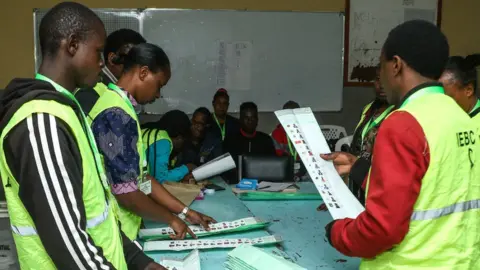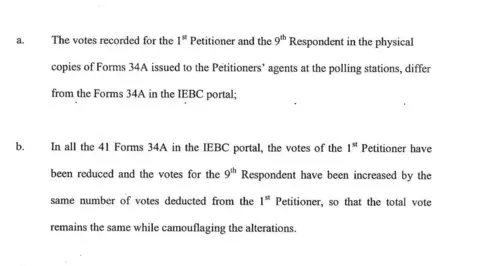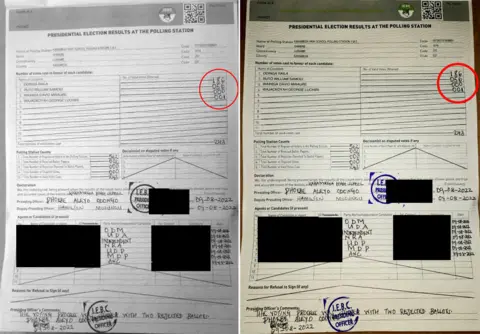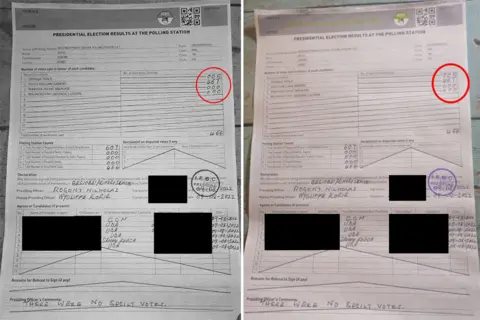Kenya election 2022: Were results sheets altered as Odinga claims?
 Getty Images
Getty ImagesWilliam Ruto was declared the winner of Kenya's presidential election over two weeks ago with 50.5% of the vote, but his opponent Raila Odinga is challenging the result, claiming it was fraudulent.
Mr Odinga's lawyers have made several allegations, one of which is that voting totals at more than 40 polling locations were tampered with to increase Mr Ruto's tally and tip it over the threshold of 50% required to win.
We've compared images of the original results sheets from these polling stations with those registered on the electoral commission website.
What's the allegation?
In Kenya, once voting has ended and the votes have been tallied, the presiding officer at each polling station publicly announces the results and fills out a declaration, known as Form 34A.
This form is signed by party representatives before being submitted electronically to the national vote tallying centre. All of these forms are then made available online by the electoral commission.
 Getty Images
Getty ImagesMr Odinga's lawyers say that at 41 polling locations the uploaded declaration forms were changed to increase Mr Ruto's share before they were formally published online by the electoral commission.
Here is the part of the petition to the Supreme Court where these allegations are made:

To unwind the legal jargon, the petition is claiming the totals on the declaration forms were changed in favour of Mr Ruto. Figures were adjusted, it says, while ensuring the overall votes cast remained the same.
The petition goes on to state there was "fraudulent interference with the electronic copies" of these forms after they were sent from the polling stations.
What did we find out?
So we set out to view as many of the original copies of the results declarations from local polling stations as we could, to see if they differed in any way from the forms uploaded online.
We realised that every signed form included contact mobile phone numbers for the party agents present at the count.
These agents are people affiliated with different political parties who observe the vote counting to make sure everything is done properly.
We then set about calling them all up individually to ask if they'd taken photographs of the results sheets at the time of the declaration - and if so, would they send them to us.
 Getty Images
Getty ImagesWe had responses from 23 agents, including six from Mr Odinga's coalition, and pictures of the original forms from 21 of the 41 locations identified.
Two agents gave us the tallies they'd written down at the time but not photographed.
In every case the results from the polling stations matched the official tallies published by the electoral commission.
A closer look at the forms

The physical copy of the result declaration form is available at the polling station on election day, and any person legally allowed to access the polling station, including the media and observers, is allowed to take a photo of the results form.
At the bottom of each of these documents there are also the names and numbers of the agents present. We've blacked these out to protect their identities.
They often take a picture of the final vote declaration document, and these are the people we contacted at the 41 locations Mr Odinga's team had highlighted.

We were then able to compare the original document with the one officially uploaded by the electoral commission to see if the vote totals were different. They were all the same.
The photos that were sent to us, apart from one, are in colour with a purple certification stamp clearly visible. So we can be confident they weren't taken from the commission website, where all the images are in black and white.
Our aim in this piece has been to look for evidence to support Mr Odinga's claims of interference and we have been unable to find any.
We have approached Mr Odinga's team to provide documentary evidence of this alleged manipulation, but none has been forthcoming.
The Supreme Court of Kenya is due to rule on the petition in the coming days.

